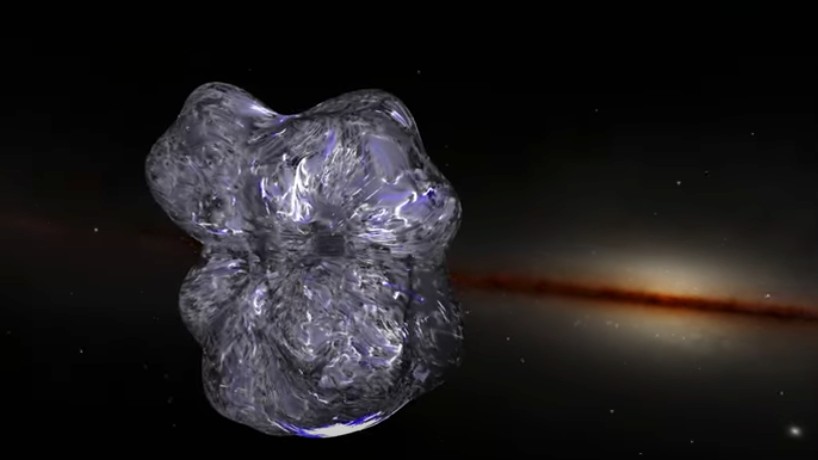Enormous 'Swiss cheese' bubble surrounding Earth mapped in incredible new images
The gigantic bubble was created by multiple supernova explosions, and researchers finally know what its magnetic field may look like.

An enormous,1,000-light-year-wide "superbubble" surrounds our planet. Now, astronomers have made the first ever 3D map of its magnetic field.
The gigantic structure, known as the "Local Bubble," is a hollow blob of diffuse, hot plasma enclosed by a shell of cold gas and dust along whose surface stars form. It is just one of numerous hollows found in the Milky Way — making our galaxy resemble an enormous slice of Swiss cheese.
Superbubbles are shock waves from the death throes of multiple massive stars, which in their final acts explode in enormous supernovas that blast out the gas and dust needed to birth new stars. As time passes, other stars, such as our own, wander inside the cavities left behind by these explosions.
Related: Earth is at the center of a 1,000-light-year-wide 'Swiss cheese' bubble carved out by supernovas
Despite having some insight into superbubble formation, astronomers are still unsure how these giant bubbles evolve through interaction with our galaxy’s magnetic field, and how this impacts star and galaxy formation. To find out more, a team of astronomers, working at a summer research program at the Harvard-Smithsonian Center for Astrophysics, charted the Local Bubble’s magnetic field.
"Space is full of these superbubbles that trigger the formation of new stars and planets and influence the overall shapes of galaxies," Theo O'Neill, who at the time was an undergraduate student in astronomy, physics and statistics from the University of Virginia, said in a statement. "By learning more about the exact mechanics that drive the Local Bubble, in which the Sun lives today, we can learn more about the evolution and dynamics of superbubbles in general."
The Milky Way, like many other galaxies, is filled with a magnetic field that gently steers stars, dust and gas into mind-bending structures such as gigantic, bone-like filaments. Astronomers are unsure what gives rise to galactic magnetic fields. The Milky Way’s magnetic field, though considerably weaker than Earth’s, permeates throughout our galaxy and deep its outer halo, subtly influencing the formation of everything around it. However, as the magnetic field’s force is weak compared with the force of gravity, and it only acts on charged particles, astronomers have long omitted magnetism from their calculations. This makes sense in the short term, but over vast cosmic timescales, it could mean that their models are overlooking substantial effects.
Sign up for the Live Science daily newsletter now
Get the world’s most fascinating discoveries delivered straight to your inbox.
"From a basic physics standpoint, we've long known that magnetic fields must play important roles in many astrophysical phenomena," Alyssa Goodman, an astronomer at Harvard University who was one of the mentors for the research program, said in the statement. "But studying these magnetic fields has been notoriously difficult. Today’s computer simulations and all-sky surveys may just finally be good enough to start really incorporating magnetic fields into our broader picture of how the universe works, from the motions of tiny dust grains on up to the dynamics of galaxy clusters."
To chart the magnetic field map, the astronomers used previous information from the European Space Agency’s (ESA) Gaia space telescope, which had inferred the rough boundaries of the Local Bubble from the concentrations of distant cosmic dust. With this in hand, the researchers turned to data from another ESA space telescope, Planck, which showed the faint microwave emissions of polarized light from the dust. As the polarization, or the direction of vibration, of the light is a key giveaway to the magnetic field acting upon the dust, the astronomers used it to stitch together the data points into a vast 3D tapestry of the superbubble’s surface.
The researchers note that to make their map they have made some big assumptions they will need to test — notably that the polarized dust lies on the bubble’s surface — but once they have fine-tuned its accuracy, they believe it could become an invaluable tool for studying star formation across our galactic backyard.
"With this map, we can really start to probe the influences of magnetic fields on star formation in superbubbles," Goodman said. "And for that matter, get a better grasp on how these fields influence numerous other cosmic phenomena."

Ben Turner is a U.K. based staff writer at Live Science. He covers physics and astronomy, among other topics like tech and climate change. He graduated from University College London with a degree in particle physics before training as a journalist. When he's not writing, Ben enjoys reading literature, playing the guitar and embarrassing himself with chess.











